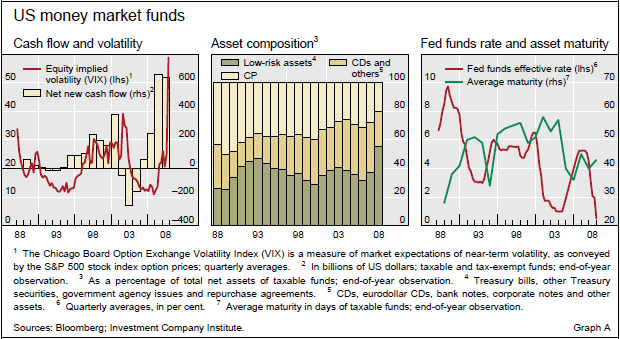Money market funds
(Extract from pages 68-69 of BIS Quarterly Review, March 2009)
Money market funds (MMFs) are collective investment schemes that invest in short-term high credit quality debt instruments and provide considerable funding in the overnight and term money markets. In the United States, MMFs are referred to as mutual funds whereas in other countries they are called investment funds. MMFs were introduced in the 1970s in the United States as an alternative to bank
deposits to circumvent regulatory caps on bank interest rates. At end-2008, MMFs managed more than $5 trillion in assets globally. The United States has the largest market for MMFs, with assets under management at end-2008 amounting to $3.8 trillion, of which $2.5 trillion accounted for by institutional investor funds and the remainder retail funds. In Europe, assets under management amounted to $1.3 trillion and more than half of this was denominated in US dollars. The dollar-denominated funds are often managed from offices located in the United States.
US MMFs are categorised on the basis of their investment objectives and the type of investors in the fund. For example, prime MMFs invest predominantly in non-government paper as opposed to government funds. If government MMFs are restricted to investing only in US Treasuries, they are referred to as Treasury funds. Depending on whether the funds are marketed to institutional or retail investors, these MMFs may be further classified into institutional prime funds or retail prime funds. Some MMFs invest in tax-exempt US municipal securities, which provide the basis for another categorisation of MMFs as taxable and tax-free funds.
MMFs operate under different regulatory regimes in the United States and Europe. The Securities and Exchange Commission regulates the credit quality, issuer concentration and maturity of assets that US MMFs can hold in their portfolios under Rule 2a-7. Under this rule, MMFs are not permitted to hold more than 5% of investments in second tier (A2-P2) paper, or to hold more than a 5% exposure to any single issuer (other than the government and agencies). Weighted average maturity of the portfolio is also restricted to 90 days or fewer. MMFs in Europe, which are dominated by institutional investor funds, are authorised under the Undertakings for Collective Investments in Transferable Securities (UCITS) Directive. The UCITS Directive allows a fund to be sold throughout the European Union subject to regulation by its home country regulator. Dollar funds domiciled in Europe generally adopt voluntarily the code of practice published by the Institutional Money Market Funds Association (IMMFA) for their investment guidelines. These guidelines are in spirit very similar to the investment restrictions under Rule 2a-7, and the weighted average maturity of portfolio holdings is even capped at a more restrictive 60 days. This is a noteworthy case of an offshore financial market adopting an onshore regulation. Many MMFs are rated by credit rating agencies, which may in turn impose additional investment restrictions.
All US and a majority of European MMFs are structured to maintain a stable net asset value (NAV) of $1 (or $10), and portfolio holdings are accounted for under amortised cost to compute NAV. Funds charge fees between 25 and 50 basis points of the NAV, and monthly dividends are paid to shareholders that reflect the average accrual income on the fund investments net of fee. As investments in MMFs can be withdrawn on the same day, these funds need to maintain a strong liquidity position to meet potential investor redemptions. Unlike bank deposits, however, investments in MMFs do not carry an official guarantee, nor are they insured or guaranteed by the fund's sponsor.1
While amortised cost provides the basis for computation of dividend payments, fund sponsors are required by regulation to also compute a shadow price for the portfolio holdings. Shadow price is the current NAV per share of the fund calculated using available market prices. Applicable regulations require that the shadow price does not materially deviate from $1. Under Rule 2a-7, this deviation is limited to 50 basis points. For Dublin-domiciled funds regulated by the Irish Financial Services Authority, the deviation limit is 30 basis points. In circumstances where the shadow price falls below this limit, fund managers are required to take corrective action. An inability to do this would result in the fund "breaking the buck", that is, valuing shares at less than $1.
The reason why MMFs did not "break the buck" in 30 years, with one exception in 1994, is that fund sponsors have provided financial support when the market value of a share threatened to fall substantially below $1. While there is no legal obligation to provide support, fund sponsors have done so to preserve their business franchise. Available evidence on parental support suggests that around 145 funds received sponsor support up until July 2007. Since then, about one third of the top 100 US MMFs have received financial support from management companies through various means (Crane Data Archives (2008)). Such support has also been extended recently by US sponsors to European-domiciled funds, which were subject to runs in September 2008. Recognising the importance of the ability and willingness of a fund sponsor to support its fund, credit agencies factor these into their fund rating decisions (Moody's (2008)). Fitch (2009) gives new emphasis to its evaluation of support and its interaction with concentration and liquidity.
Support can take various forms. The fund sponsor can purchase the security that has experienced a credit event from the fund at par or can provide the fund with an A1-P1 letter of credit or guarantee covering the par amount of the security. A blanket guarantee of the NAV could lead to the consolidation of the MMF into the sponsor's balance sheet, but support for individual securities has thus far been interpreted as not requiring such consolidation (SEC (2008)).
Considering that MMFs invest in short-term and high credit quality securities and are structured to provide principal protection, inflows into these funds usually rise during periods of heightened investor risk aversion (Graph A, left-hand panel). During the current financial market crisis, MMFs have been important beneficiaries, with assets under management rising by more than 20% in 2008. In fact, end-2008 holdings in MMFs exceeded those in equity mutual funds in the United States for the first time in the last 15 years. As net inflows into MMFs have grown rapidly since 2007, competition between funds to gain market share has increased. This competition has been further intensified by the growth in money fund portals, which offer institutional investors and corporate treasuries not only a wider range of funds to invest in, but also greater flexibility in switching among them.
As investors in short-term debt, MMFs are important providers of liquidity to financial intermediaries through purchases of certificates of deposit (CDs) and commercial paper (CP) issued by banks, and through repo transactions. For example, MMFs held nearly 40% of the outstanding volume of CP in the first half of 2008. Consequently, when MMFs shift away from these assets into safer ones, funding liquidity for financial institutions can be affected. The shifts in the asset composition and maturity, however, tend to be influenced by credit market conditions, market liquidity and level of interest rates. Interpreting falling interest rates as periods of weaker credit market conditions, aggregate portfolio holdings of MMFs have shifted to low-risk assets in such periods (Graph A, centre and right-hand panels). To maintain yield in a falling interest rate environment, the shift to safer assets is usually accompanied by maturity extension.
1 Following the Lehman bankruptcy, the US Treasury unveiled a temporary guarantee programme for investments held in MMFs.


